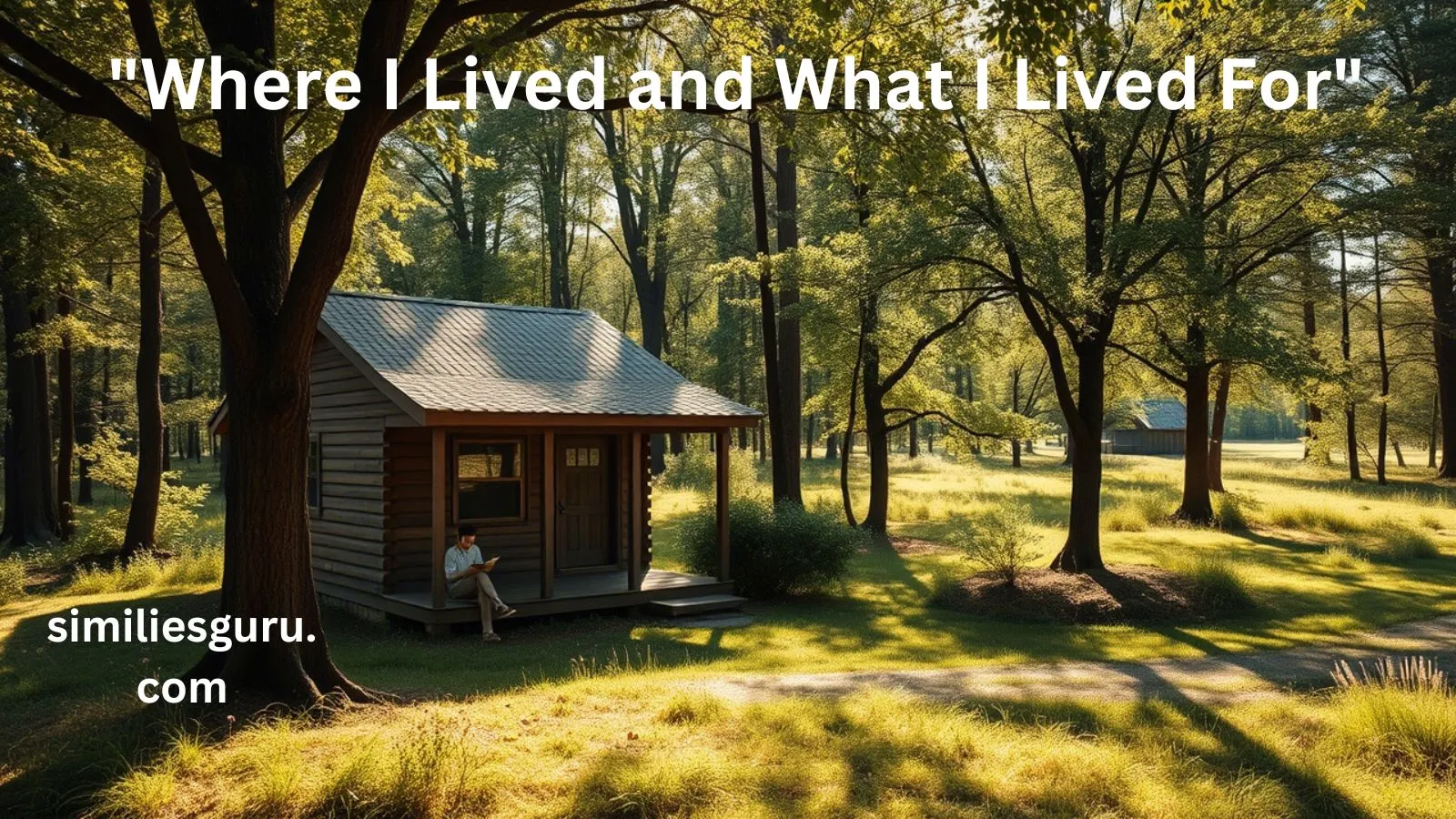Henry David Thoreau’s Where I Lived and What I Lived For is a timeless essay that explores themes of simplicity, self-reliance, and the pursuit of meaning. One of the most striking features of Thoreau’s writing is his use of figurative language, particularly similes, to convey his ideas vividly. Similes are comparisons that use “like” or “as” to draw parallels between two seemingly unrelated things, creating imagery that resonates with readers.
In this article, we’ll explore 20 similes from Where I Lived and What I Lived For, analyze their significance, and provide casual alternatives to these phrases. Additionally, we’ll discuss examples of similes in poems for kids and offer 9 texting examples that are user-friendly and optimized for Google.
Understanding Similes: A Brief Overview
Before diving into Thoreau’s work, it’s essential to understand what similes are and why they matter. Similes are a type of figurative language that compare two things using “like” or “as.” They help writers create vivid imagery, evoke emotions, and make complex ideas more relatable. For example, saying “Her smile was as bright as the sun” paints a clearer picture than simply saying “Her smile was bright.”
Similes are commonly used in literature, poetry, and everyday language. They’re especially effective in engaging young readers, which is why they’re prevalent in children’s poems.
20 Similes in Where I Lived and What I Lived For
Thoreau’s essay is rich with similes that enhance his philosophical reflections. Below are 20 examples, along with their interpretations:
- “Time is but the stream I go a-fishing in.”
- Interpretation: Thoreau compares time to a stream, suggesting that life is a journey where we can “fish” for experiences and wisdom.
- Casual Alternative: “Time is like a river—you can’t stop it, but you can enjoy the ride.”
- “The morning wind forever blows, the poem of creation is uninterrupted.”
- Interpretation: The wind is compared to a continuous poem, symbolizing the eternal beauty of nature.
- Casual Alternative: “The morning breeze feels like a never-ending song.”
- “Our life is like a German Confederacy, made up of petty states.”
- Interpretation: Thoreau likens life to a fragmented political system, emphasizing its complexity and lack of unity.
- Casual Alternative: “Life is like a puzzle with too many pieces.”
- “I went to the woods because I wished to live deliberately, to front only the essential facts of life, and see if I could not learn what it had to teach, and not, when I came to die, discover that I had not lived.”
- Interpretation: While not a direct simile, this line implies that life is like a classroom where we must actively learn its lessons.
- Casual Alternative: “Life is like a school—you only get out of it what you put into it.”
- “The universe is wider than our views of it.”
- Interpretation: Thoreau compares the universe to a vast landscape, suggesting that human understanding is limited.
- Casual Alternative: “The world is bigger than we can imagine.”
- “We are as much as we see.”
- Interpretation: This simile suggests that our perception shapes our reality.
- Casual Alternative: “What we see is what we become.”
- “The light which puts out our eyes is darkness to us.”
- Interpretation: Thoreau compares overwhelming light to darkness, highlighting how excess can obscure understanding.
- Casual Alternative: “Too much of anything can blind you.”
- “Our life is frittered away by detail.”
- Interpretation: Life is compared to something being wasted or scattered, emphasizing the importance of focusing on what truly matters.
- Casual Alternative: “Life gets lost in the little things.”
- “The surface of the earth is soft and impressible by the feet of men.”
- Interpretation: The earth is likened to a soft material, symbolizing its vulnerability to human impact.
- Casual Alternative: “The ground feels like clay under our feet.”
- “The stars are the apexes of what wonderful triangles!”
- Interpretation: Thoreau compares stars to geometric shapes, emphasizing the beauty and order of the cosmos.
- Casual Alternative: “The stars look like dots connecting a giant picture.”
- “The life in us is like the water in the river.”
- Interpretation: Life is compared to flowing water, symbolizing its constant movement and change.
- Casual Alternative: “Life flows like a river.”
- “Our thoughts are the epochs in our lives.”
- Interpretation: Thoughts are likened to significant events, highlighting their impact on our lives.
- Casual Alternative: “Our thoughts shape our journey.”
- “The intellect is a cleaver; it discerns and rifts its way into the secret of things.”
- Interpretation: The intellect is compared to a sharp tool, symbolizing its ability to uncover truths.
- Casual Alternative: “The mind is like a knife—it cuts through confusion.”
- “The world is but a canvas to our imagination.”
- Interpretation: The world is likened to a blank canvas, suggesting that we have the power to create our reality.
- Casual Alternative: “The world is like a playground for our ideas.”
- “The morning is the most memorable season of the day.”
- Interpretation: Morning is compared to a season, emphasizing its significance and freshness.
- Casual Alternative: “Morning feels like a new beginning.”
- “Our houses are such unwieldy property that we are often imprisoned rather than housed in them.”
- Interpretation: Houses are likened to prisons, highlighting how materialism can trap us.
- Casual Alternative: “Big houses can feel like cages.”
- “The sun is but a morning star.”
- Interpretation: The sun is compared to a star, reminding us of its place in the vast universe.
- Casual Alternative: “The sun is just another star in the sky.”
- “The laws of the universe are not indifferent, but are forever on the side of the most sensitive.”
- Interpretation: Laws are likened to allies, suggesting that they favor those who are attuned to nature.
- Casual Alternative: “The universe rewards those who pay attention.”
- “The wind that blows is all that anybody knows.”
- Interpretation: The wind is compared to knowledge, symbolizing its elusive nature.
- Casual Alternative: “The wind carries secrets we can’t understand.”
- “The life which men praise and regard as successful is but one kind.”
- Interpretation: Life is compared to a single option among many, challenging conventional notions of success.
- Casual Alternative: “Success is just one way to live.”
Similes in Poems for Kids
Similes are a fantastic way to engage young readers. Here are a few examples from children’s poetry:
- “The moon is like a silver boat sailing in the sky.”
- “Her laughter was like a melody, sweet and clear.”
- “The clouds are like fluffy pillows floating above.”
- “His temper was like a volcano, ready to erupt.”
- “The stars are like diamonds scattered across the night.”
These examples show how similes can make abstract concepts more tangible and relatable for kids.
9 Texting Examples Optimized for Google
Here are 9 user-friendly texting examples that incorporate similes and are optimized for Google:
- “Your smile is like sunshine—it brightens my day! ☀️”
- “This coffee is as strong as an ox. I needed this! ☕”
- “The party was lit like a Christmas tree! �”
- “I’m as busy as a bee today. Let’s catch up later! 🐝”
- “Your voice is like music to my ears. Can’t wait to hear it again! 🎶”
- “This pizza is as cheesy as a rom-com. Love it! 🍕”
- “The weather is as unpredictable as a mood ring. 🌦️”
- “I’m as happy as a clam right now. Life is good! 😊”
- “This book is like a rollercoaster—full of twists and turns! 📚”
These examples are concise, engaging, and perfect for modern communication.
Conclusion
Similes are a powerful tool for writers and speakers alike. In Where I Lived and What I Lived For, Thoreau uses them to convey profound ideas about life, nature, and human existence. By analyzing these similes and exploring their casual alternatives, we gain a deeper appreciation for Thoreau’s genius and the versatility of figurative language.



